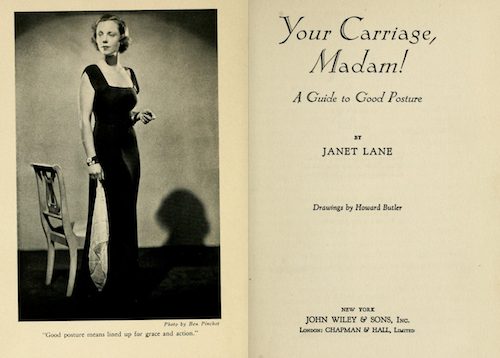
Image Credit:
You don’t have to be a dyed-in-the-wool empirist to believe that we must learn how to move and hold our bodies. Yet who among us learned anything about posture at school?
Not I, at any rate, although maybe that’s because I went to public school in the United States. We had P.E. (Physical Education), presumably under the theory that students are better able to concentrate in class if they run around a bit from time to time. Yes, like a great many, I was forced from Middle School through High School to go through the usual routine of locker room, stretching, running, and back to locker room, a ritual that amounted to little more than a daily opportunity for social-jockeying and hazing. That is to be expected, of course, and can be chalked up to “social skills,” but we weren’t learning the first thing about, for instance, strength, flexibility, speed, agility, nutrition, breathing, relaxation, musculature, injuries: in short, any of the well developed canon of learning which pertains to the body and its betterment. (Perhaps the P.E. teachers thought we were learning about all that in “Health” class; but where I went to school they might as well have called it “Pictures of STDs” class.)
One of the innumerable things I didn’t think a whit about until I got into my twenties, then, was posture. By the time I became aware of mine, it was atrocious.
How did it get so bad?
As a book-inclined and myopic child of middle class parents, I spent a lot of time inside, pouring over a desk, and then later, leaning in towards a computer. In High School, I did endless math exercises sitting on the couch with the book on my lap. Looking out over the classroom, my instructors must have seen row after row of slumped-shoulders, pooched out tummies, and c-shaped backs, all like mine. I wonder if they gave it a second thought.
No doubt the government hesitates to weigh in on such personal and therefore political issues as proper posture, but I see no reason why professional educators should not take on teaching students about fitness. It’s a specialized subject, experience doesn’t necessarily impart it to you, and neither do your parents.
Now, what accounts for this oversight, not to say repression, of students’ bodies in U.S. institutions of public education? Our dirty minds, no doubt, and a dread of any accusation of improper physical contact between adults and youths. Probably you could describe the entire social apparatus of modern-day public schools -- rules, organizational hierarchies, classroom practices, et al. -- as the protection of the adults from the students' sexualities, and vice versa.
That’s a big reason, and it explains some of the assumptions that undergird postwar social institutions, theories, and technologies.
The personal computer is a prime example.
Computers were developed according to a Cartesian dualism in which the cognitive brain is entirely disassociated from the fleshy body. This dualism complements nicely the mortification of the body central to influential Judeo-Christian traditions. Pair Cartesian dualism with Christian mortification and you have the unconscious mindset, I would wager, of the mostly engineers who sat around in air-conditioned rooms in the fifties, sixties, and seventies, inventing computers. (The Silicon Valley crowd has a cool image, nowadays, but I ask you: is the iPad embodied computing? Or is it just a touch-screen?)
In a word, computers, like the (U.S.) public schools, are made for myopic, seated, hunch-shouldered, data-fetishists. No chance for improper contact between brains in jars, is there?
Once upon a time, though, posture was taught. “Your carriage, Madam!” -- a title only history could provide -- is an illustrated handbook published in the 1930s. It smacks of blue blood and patriarchy, of course, but flipping through its pages, I’m struck with the good sense of several of its illustrations and even some of its advice.
You had to be one of the “ornamental sex,” it would appear, to be taught “carriage” in the 1930s. And no doubt, you were learning carriage when you could have been learning mathematics, a boy’s subject. But when the middle-class threw out the bath water, is it possible they paid too little heed to the baby? If so, it’s too bad because holding oneself in a position of balance and strength (or as the 1930s could put it, “grace” and “action”) should not be the exclusive province of a by-gone elite.
And in fact, middle class people are starting to recognize the deleterious effects of their bad posture. The standing desk strikes me as a healthier and more embodied practice of working inside.
We need to teach posture to children in the public schools. Now, I know that means overcoming quite a lot. If you’ve read this far, I can imagine the doubts quickly populating your mind. You’re thinking I’m naïve. Middle School and High School is a jungle: drugs, guns, and teen pregnancy are today’s concerns. Posture, for better or worse, is a word for yester-year.
Would I have learned posture even if my high school phys-ed instructors had taught me how to stretch -- and I mean really taught it, as a good practical yoga teacher does, with words and demonstration, and without needing to touch you? Certainly I would not have done anything to open myself to the shame tactics of the other boys. My teachers reckoned on this and had thoroughly reconciled themselves to the fact that we had dirty minds and were little hellions. And they were right. We would have jeered and giggled. We were too cool for school.
But, you know, maybe later that night, in the privacy of my own room, I might have tried out a downward dog. Teaching, day in day out, has got to be one of the hardest professions because it requires unflagging idealism. If one student is listening, then it’s worth teaching, isn’t it?

